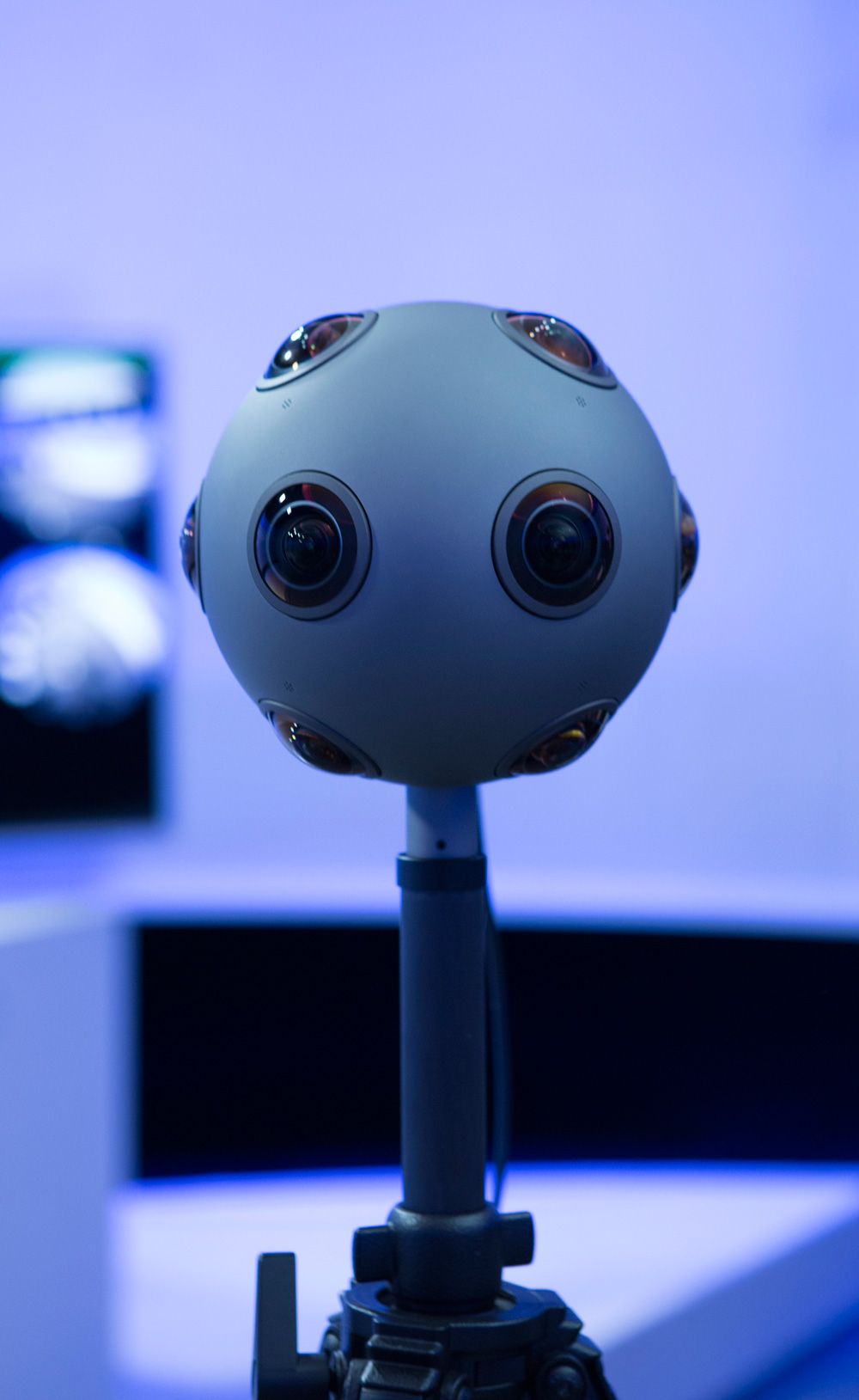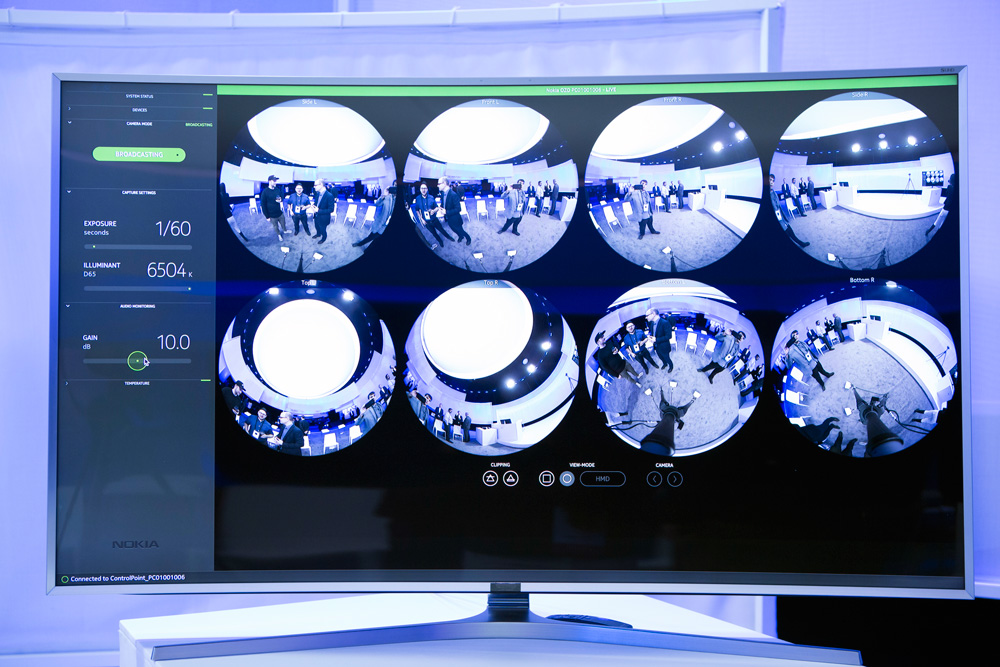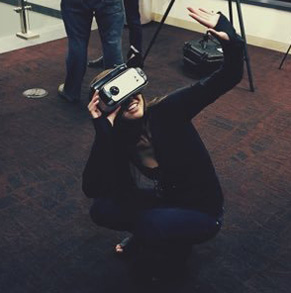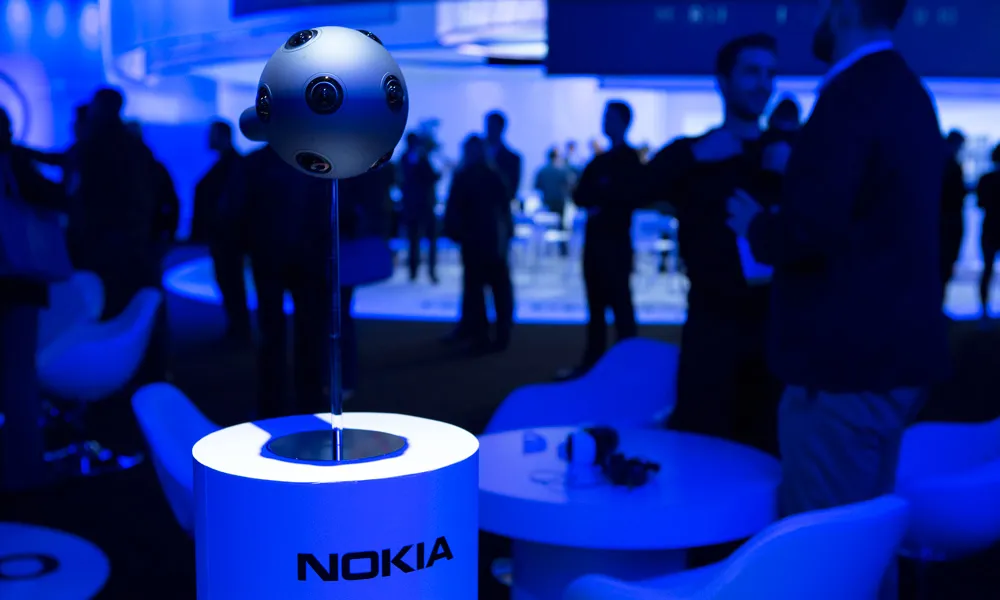The race to building the perfect virtual reality camera is on.
This year several camera systems have been announced: Jaunt One, Odyssey (Google Jump), and Lytro Immerge. Last night, Nokia officially joined the race with OZO, a $60,000 professional 360º camera shipping in Q1 of 2016.

The unveiling of Nokia’s OZO was quite a spectacle. Everything from the demo bar to the keynote stage had a futuristic tone. For those who are unfamiliar with OZO, it a compact aluminum camera weighing about 9.5lbs that has an array of eight lenses each with 2K by 2K sensors and eight microphones. For those of you who don’t have the $60,000 to drop on Nokia’s camera, don’t worry, they plan on having available for rental.
Last night, I had a chance to try all of OZO’s demos: the 360º live stream of Best Coast performing at the top of the Capitol Record building, Mutiny (Music Video), NASA training, a recorded video of man performing on a stage, a short film about pirates, and their spatial audio room. Demos were given on the Gear VR, HTC Vive, Oculus Crescent Bay, and StarVR but I watched everything on the Gear VR and Vive.
PROS
- Spatial Audio: This is probably the best feature of the camera. In the spatial audio room, while you are wearing noise cancelling headphones and a headset, they mic’d a speaker and sax player and had them walking around a room speaking and playing. The tracking was pretty amazing. Capturing spatial audio is such a key part of presence and it’s exciting that Nokia has addressed this issue by integrating it into a video capture system.
- Live Monitoring: The ability to preview your content real time while you’re shooting is advantageous and the monitoring is accurate. It allows for real-time tweaks while shooting.
- Design: The design overall is compact, clean, and relatively light.

CONS
- The Jumping Image: The picture is perfect… and it moves. The moment you turn your head horizontally, or vertically (especially looking down) what you see actually shifts. This is because what you’re viewing isn’t stitched together, rather it just changes which camera angle you’re viewing from. Vesa Rantanen, Head of R&D, told me that this jumping image is due to their live stream rendering postproduction pipeline. I noticed this jumping image in the NASA Demo, Music Demo, and in the 360 live stream
- The Wrapping of the Horizon: The horizon is straight… then its not. In the initially field of view that you’re given, the horizon is perfect, but then it begins to slightly lose its 180 when you turn your head horizontally. It’s subtle and the average viewer may not pick up on it, but its still there.
- The Back Stitch Line: Ever so subtle… it’s still there. I saw this in all of the demos except the pirate short film.
- Not Fully 360, 3D: Unfortunately, the back is monoscopic; however, this does not bother me as much. If content is compelling, it is compelling.
- Image Quality: The Mutiny Demo was probably the best demonstration of the OZO camera. It was a rather seamless experience (except for the wrapping of the horizon and back stitch line). The 3D looked great, but overall it’s not significantly better than what you would see coming out of a GoPro rig.
What Nokia has done is impressive, but it is a stepping-stone rather than the final solution. They’ve solved a lot of issues that people would run into during post production by having a camera system where all the lenses are already synced and the fact that audio and video comes in one file. The camera can capture up to 45 minutes of footage which is more than what other cameras can do. Although the sensors are 2K x 2K, the camera is more compact and is portable.
In the end, Nokia’s camera is better than the standard 3D printed Go-Pro camera rigs (Jump/Odyssey not withstanding) with a sleek form factor and built-in spatial audio, but the end quality may not be enough to justify the $60,000 price tag. There is still a lot of work to be done in terms of creating the camera that will be the industry standard, but this is taking a step in the right direction.
Full Specs:
| Video Sensor Type | Progressive Scan with Global Shutter |
| Video Sensor Array | Eight, synchronised, 2K x 2K sensors |
| Video Area Coverage | Full-spherical, 360 x 180 degrees |
| Min Imaging Distance | 0.5m / 20″ (spherical video coverage) |
| Stereoscopic Coverage | Centerline +/- 130(h), +/- 65(v) degrees |
| Lens Interoptic Distance | Effective max. 86 mm / 3.4″ |
| Lens Angle of View | 195 degrees per lens |
| Relative Aperture | f/2.4 |
| Video Dynamic Range | 60 dB / 10 stops |
| Base Color Temperature | 5,000 degrees Kelvin |
| Base Sensitivity | ISO 400 |
| Audio Sensor Type | Omnidirectional, solid state |
| Audio Area Coverage | Full-spherical, 360 x 360 degrees |
| Audio Dynamic Range | 64dB S/N, 120dB max SPL |
| Master File Format | MOV wrapped OZO Virtual Reality with 8Ch raw Video and 8Ch PCM Audio |
| Video Compression | Wavelet-based raw |
| Media Module | 500GB, Solid State Media |
| Record Duration | 45 min per Media Module |
| Program Output | 3G-SDI SMPTE 242M, DIN connector |
| Capture Frame Rate | 30.00 fps |
| Cooling System | Passive (fanless) design |
| Battery Pack | Rechargeable Lithium Ion |
| Power Consumption | 12V DC, approx 30W in record mode |
| OZO Remote Application | Available for OSX® 10.10 Yosemite |
| Camera Control | via 802.11 Wifi |
| Monitor Output | HDMI, Stereoscopic Virtual Reality render |
| OZO Creator Application | Available for OSX® 10.10 Yosemite |
| Audio Mix Preview Output | MOV, monoscopic stitched panorama |
| Video Composition Output | DPX, 8K x 4K, 10-bit, sRGB color space |
| Weight | 4.2kg / 9.3lbs including Battery |
| Construction | Milled Aluminium Alloy |
| Color | Lava Grey |
| Dimensions – camera head only | 264 x 170 x 160mm / 10.4 x 6.7 x 6.3″ |
| Dimensions – with camera mount | 264 x 170 x 238mm / 10.4 x 6.7 x 9.4″ |
| Planned Certifications | CE, FCC Part 15 Class A |
| Operating Temperature | 0C to +25C (+32F to +77F) |
| Storage Temperature | -40C to +50C (-4F to +122F) |
 Jenn Duong is a passionate virtual reality enthusiast and the business development manager at KoomVR, a mobile VR content distribution company based in Los Angeles, CA. Outside of work, Duong manages Women in VR, an organization dedicated to bringing more women into the VR industry, and is actively involved in the VR community. You can follow her on Twitter @jenndefer.
Jenn Duong is a passionate virtual reality enthusiast and the business development manager at KoomVR, a mobile VR content distribution company based in Los Angeles, CA. Outside of work, Duong manages Women in VR, an organization dedicated to bringing more women into the VR industry, and is actively involved in the VR community. You can follow her on Twitter @jenndefer.


























